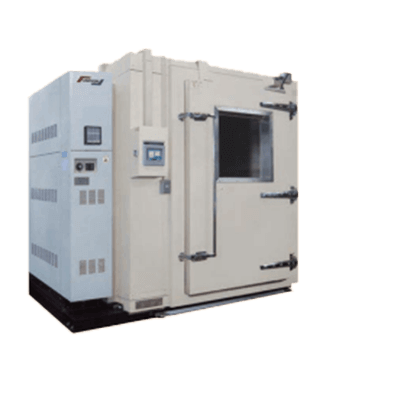What Is a Temperature/Humidity Chamber?

A temperature/humidity chamber is a device or system used to maintain a constant temperature and humidity.
These chambers are essential for testing product durability and reliability across various industrial sectors. They primarily simulate extreme climatic conditions to evaluate a product’s longevity under typical usage scenarios.
Uses of Temperature/Humidity Chamber
Temperature/humidity chambers serve various purposes. Below are some common applications.
1. Laboratories and Research Facilities
Controlled temperature and humidity conditions are crucial for scientific research and experiments. These chambers are widely utilized in biology and chemistry labs to ensure precise environmental settings.
2. Manufacturing
Some manufacturing processes of products and materials demand consistent temperature and humidity levels. These chambers are employed in sectors like food processing, pharmaceuticals, and electronics manufacturing.
They are also beneficial during development, quality assurance, and production. They are particularly used for testing quality degradation in raw materials, food products, and, in the automotive industry, for component testing.
3. Warehouses and Storage Facilities
Controlling temperature and humidity is crucial for storing certain items. These chambers help preserve the quality of products, preventing spoilage and degradation. They are used for storing food, and wine, and protecting museum exhibits.
4. Medical Facilities
Hospitals and medical facilities often need stable temperature and humidity conditions. These chambers are critical for maintaining cleanliness and safety, such as in operating rooms and for infection control. They are also used for culturing plants and microorganisms.
Principle of Temperature/Humidity Chamber
Temperature/humidity chambers comprise temperature control, dehumidification, internal circulation, and control devices. The temperature/humidity controller inputs settings, while sensors detect and adjust environmental changes.
Refrigeration units and heaters finely control temperature and humidity, humidifying or dehumidifying as required. To maintain uniform conditions, a sirocco fan or other air circulation devices ensure a stable environment.
Various control devices are available, including those with multilingual displays and LAN connectivity for internal monitoring and test control. They can send email alerts during abnormalities and offer remote monitoring capabilities.
Types of Temperature/Humidity Chamber
Temperature/humidity chambers offer temperature control from -20 °C to 180 °C, humidity control from 5 to 98% rh, and capacities from 120 to 1,000 L. They come in various models, allowing selection based on temperature, humidity range, and capacity.
1. Steam Temperature/Humidity Chamber
Steam temperature/humidity chambers, a common humidifier type, heat water to generate steam, which is then dispersed into the air to raise humidity. Fans or blowers aid in distribution.
They typically include a heating element and a water tank. The heater warms the water, turning it into steam, efficiently generating vapor. This direct heating allows for a rapid increase in humidity.
Some models have safety features that automatically shut off if they run out of water or overheat, enhancing user safety.
2. Drying Temperature/Humidity Chamber
To reduce humidity, these chambers use refrigeration cycles or dehumidifiers. The cooling cycle cools the air, condensing moisture, which is then removed, releasing dry air.
Dehumidifiers absorb moisture to lower humidity. They need periodic removal or regeneration to maintain efficiency.
Unlike standard chambers, dry temperature/humidity chambers may lack a humidification feature to increase humidity.